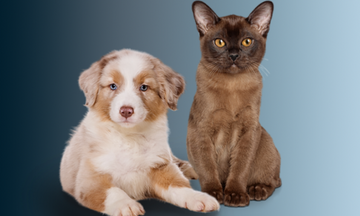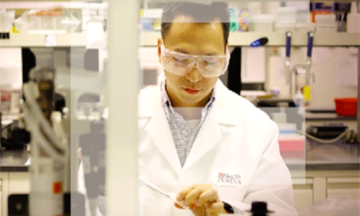微生物组基础知识

虽然肠道微生物组到目前为止已得到了大多数关注,但身体表面和体内也存在着大量微生物组。1
微生物组存在于体内微生物寄居的任何地方,包括口腔、结膜、外耳、皮肤、上呼吸道和下呼吸道、生殖道和泌尿道。根据身体部位的物理和化学特性(包括 pH 值、局部解剖和湿度水平),身体部位的微生物组成存在显著差异。2
随着非肠道微生物组研究的加速发展,人类微生物组的研究正迅速扩展。
而对犬和猫非肠道微生物组的研究落后于人类,这增加了影响宿主健康的机会。


口腔微生物组
尽管与肠道有物理和功能联系,但犬和猫的口腔微生物组是一种独特的微生物组,约有 5 千万至 1 亿个细菌(大约 200 个菌种)。2-4研究表明,组成犬和猫的口腔微生物组的主要菌门相同,但菌种间的丰度不同。3、5、6、7此外,微生物群因在口腔内的位置不同而有所差异。8
犬的口腔微生物组似乎高度保守,犬种之间无显著差异。3相比之下,已发现多个猫品种之间以及户外活动猫与仅室内活动猫之间的口腔微生物组的多样性和相对丰度存在显著差异。9
据报告,口腔微生物组的变化与生产方式(剖腹产与自然生产)、5猫饮食方式(湿粮与干粮,以及将饮食从哺乳改为市售食物)、5、10向犬喂食减少牙菌斑的咀嚼物、11投喂口服益生菌、12牙病预防、13口腔疾病(例如牙周炎、牙龈炎、牙龈口腔炎)均有关。14-18然而,微生物组变化是否先于疾病并容易诱发疾病,或者微生物组变化是否代表了因应对环境变化而发生的微生物群落变化,这些仍需要进一步研究。3、19、20
尽管有证据表明确实发生变化,但口腔微生物组具有灵活的适应能力。3、13
皮肤微生物组
犬和猫的皮肤微生物组的主要菌门类似,但比人类皮肤微生物组更具多样性。21正如在口腔微生物组中发现的情况一样,犬和猫的皮肤微生物组的主要菌门相同,但丰度不同。21在这两个物种中,显示毛发部位的微生物数量(丰富度)高于粘膜和粘膜皮肤交界处的数量。21人们对皮肤微生物组在健康和疾病中的总体作用知之甚少22,但皮肤作为主要屏障的作用及其与免疫系统的密切联系表明它对宿主健康起到关键作用。
关于犬和猫的皮肤微生物组的大多数研究均侧重于比较健康犬和猫与过敏或特应性犬和猫。
不出所料,研究记录了健康猫与过敏猫以及健康犬与过敏或特应性犬的皮肤微生物组存在显著差异,多样性和丰富度降低与过敏和特应性疾病相关。21、23-26
探索Microbiome Forum的其他部分
了解更多信息
- Yang, J. (2012, July 16). The Human Microbiome Project: Extending the definition of what constitutes a human. National Humane Genome Research Institute Genome Advance of the Month. https://www.genome.gov/27549400/the-human-microbiome-project-extending-the-definition-of-what-constitutes-a-human
- Koidl, L., & Untersmayr, E. (2021).The clinical implications of the microbiome in the development of allergy diseases. Expert Review of Clinical Immunology, 17, 115—126. doi:10.1080/1744666X.2021.1874353
- Bell, S. E., Nash, A. K., Zanghi, B. M., Otto, C. M., & Perry, E. B. (2020). Assessment of the stability of the canine oral microbiota a er probiotic administration in healthy dogs over time. Frontiers in Veterinary Science, 7, 616. doi:10.3389/fvets.2020.00616
- Dewhirst, F. E., Klein, E. A., Bennett, M.-L., Cro , J. M., Harris, S. J., & Marshall-Jones, Z. V. (2015). The feline oral microbiome: A provisional 16S rRNA gene based taxonomy with full-length reference sequences. Veterinary Microbiology, 175, 294—303. doi:10.1016/j.vetmic.2014.11.019
- Spears, J. K. (2017, May 4-6) Development of the oral microbiome in kittens. Proceedings of the Companion Animal Nutrition Summit, Vancouver, B. C., Canada, 73–81.
- Dewhirst, F. E., Klein, E. A., Thompson, E. C., Blanton, J. M., Chen, T., Milella, L.,…Marshall-Jones, Z. V. (2012). The canine oral microbiome. PLoS ONE, 7(4), e36067. doi:10.1371/journal.pone.0036067
- Sturgeon, A., Pinder, S. L., Costa, M. C., Weese, J. S. (2014). Characterization of the oral microbiota of healthy cats using next-generation sequencing. The Veterinary Journal, 201, 223–229. doi:10.1016/j.tvjl.2014.01.024
- Ruparelli, A., Inui, T., Staunton, R., Wallis, C., Deusch, O., & Holcombe, L. J. (2020). The canine oral microbiome: variation in bacterial population across different niches. BMC Microbiology, 20, 42. doi:10.1186/s12866-020-1704-3
- Older, C. E., Diesel, A. B., Lawhon, S. D., Queiroz, C. R. R., Henker, L. C., & Hoffmann, A. R. (2019). The feline cutaneous and oral microbiota are influenced by breed and environment. PLoS ONE, 14(7), e0220463. doi:10.1371/journal.pone.0220463
- Adler, C. J., Malik, Browne, G. V., & Norris, J. M. (2016). Diet may influence the oral microbiome composition in cats. Microbiome, 4, 23. doi:10.1186/s40168-016-0169-y
- Oba, P. M., Carroll, M., Alexander, C., Lye, L., Somrak, A., Keating, S.,…Swanson, K. S. (2020). Oral microbiota populations of adult dogs consuming dental chews demonstrated to reduce dental plaque and calculus. Journal of Animal Science, 98(Suppl 4), 61.
- Mäkinen, V.-M., Mäyrä, A., & Munukka, E. (2019). Improving the health of teeth in cats and dogs with live probiotic bacteria. Journal of Cosmetics, Dermatological Sciences and Applications, 9, 275–283. doi:10.4236/jcdsa.2019.94024
- Flancman, R., Singh, A., & Weese, J. S. (2018). Evaluation of the impact of dental prophylaxis on the oral microbiota of dogs. PLoS ONE, 13(6), e0199676. doi:10.1371/journal.pone.0199676
- Dolieslager, S. M. J., Bennett, D., Johnston, N., & Riggio, M. P. (2013). Novel bacterial phylotypes associated with the healthy feline oral cavity and feline chronic gingivostomatitis. Research in Veterinary Science, 94, 428–432. doi:10.1016/j.rvsc.2012.11.003
- Davis, E. M. (2016). Gene sequence analysis of the healthy oral microbiome in humans and companion animals. Journal of Veterinary Dentistry, 33(2), 97-107. doi: 10.1177/0909765416657239
- Nakanishi, H., Furuya, M., Soma, T., Hayashiuchi, Y., Yoshicuhi, R., Matsubayashi, M.,…Sasai, K. (2019). Prevalence of microorganisms associated with feline gingivostomatitis. Journal of Feline Medicine and Surgery, 21(2), 103–108. doi:10.1177/1098612X18761274
- Harris, S., Cro , J., O’Flynn, C., Deusch, O., Colyer, A., Allsopp, J.,…Davis, I. J. (2015). A pyrosequencing investigation of differences in the feline subgingival microbiota in health, gingivitis and mild periodontitis. PLoS ONE, 10(11), e0136986. doi:10.1371/journal.pone.0136986
- Older, C. E., de Oliveira Sampaio Gomes, M., Hoffmann, A. R., Policano, M. D., Cruz dos Reis, C. A., Carregaro, A. B.,…Carregaro, V. M. L. (2020). Influence of the FIV status and chronic gingivitis on feline oral microbiota. Pathogens, 9, 383. doi:10.3390/pathogens9050383
- Davis, I. J., Wallis, C., Deusch, O., Colyer, A., Milella, L., Loman, N., Harris, S. (2013). A cross-sectional survey of bacterial species in plaque from client owned dogs with healthy gingiva, gingivitis or mild periodontitis. PLoS ONE, 8(12), e83158. doi:10.1371/journal.pone.0083158
- Holcombe, L. J., Patel, N., Colyer, A., Deusch, O., O’Flynn, C., & Harris, S. (2014). Early canine plaque biofilms: Characterization of key bacterial interactions involved in initial colonization of enamel. PLoS ONE, 9(12), e113744. doi:10.1371/journal.pone.0113744
- Older, C. E., Diesel, A., Patterson, A. P., Meason-Smith, C., Johnson, T. J., Mansell, J.,…Rodrigues Hoffmann, A. (2017). The feline skin microbiota: The bacteria inhabiting the skin of healthy and allergic cats. PLoS ONE, 12(6), e0178555. doi:10.1371/journal.pone.0178555
- Weese, J. S. (2013). The canine and feline skin microbiome in health and disease. Veterinary Dermatology, 24, 173–e31. doi:10.1111/j.1365-3164.2012.01076.x
- Fazakerley, J., Nuttall, T., Sales, D., Schmidt, V., Carter, S. D., Hart, C. A., & McEwan, N. A. (2009). Staphylococcal colonization of mucosal and lesional skin sites in atopic and healthy dogs. Veterinary Dermatology, 20(3), 179–184. doi:10.1111/j.1365-3164.2009.00745.x
- Furiani, N., Scarampella, F., Martino, P. A., Panzini, I., Fabbri, E., & Ordeix, L. (2011). Evaluation of the bacterial microflora of the conjunctival sac of healthy dogs and dogs with atopic dermatitis. Veterinary Dermatology, 22(6), 490–496. doi:10.1111/j.1365-1365-3164.2011.00979.x
- Rodrigues Hoffmann, A., Patterson, A. P., Diesel, A., Lawhon, S. D., Ly, H. J., Elkins Stephenson, C.,…Suchodolski, J. S. (2014). The skin microbiome in healthy and allergic dogs. PLoS One, 9(1), e83197. doi:10.1371/journal.pone.0083197
- Bradley, C. W., Morris, D. O., Rankin, S. C., Chain, C. L., Misic, A. M., Houser, T.,…Grice, E. A. (2016). Longitudinal evaluation of the skin microbiome and association with microenvironment and treatment in canine atopic dermatitis. Journal of Investigative Dermatology, 13(6), 1182–1190. doi:10.1016/j.jid.2016.01.023


